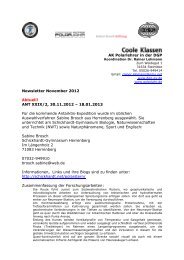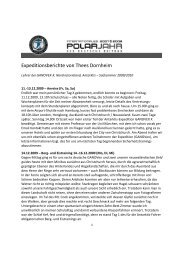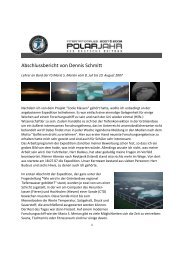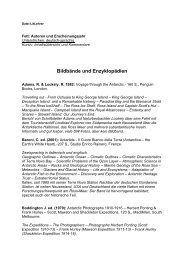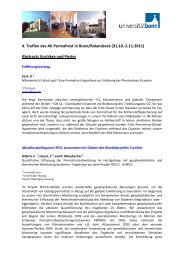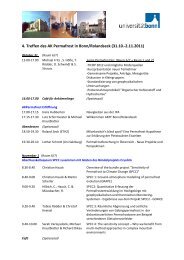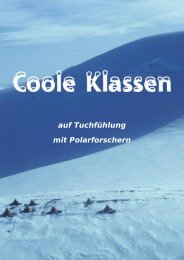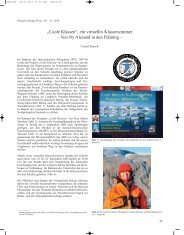Berichtsheft - Deutsche Gesellschaft für Polarforschung eV
Berichtsheft - Deutsche Gesellschaft für Polarforschung eV
Berichtsheft - Deutsche Gesellschaft für Polarforschung eV
Erfolgreiche ePaper selbst erstellen
Machen Sie aus Ihren PDF Publikationen ein blätterbares Flipbook mit unserer einzigartigen Google optimierten e-Paper Software.
Basement and sedimentary architecture of the Amundsen Sea Embayment:<br />
How close do we come to reconstructing West Antarctica’s glacial history?<br />
Karsten Gohl, Gabriele Uenzelmann-Neben, Gerhard Kuhn, Ansa Lindeque, Thomas<br />
Kalberg, Estella Weigelt & Astrid Denk<br />
Alfred-Wegener-Institut <strong>für</strong> Polar- und Meeresforschung, Bremerhaven; karsten.gohl@awi.de<br />
Recent melt and retreat rates of glacier systems in the Amundsen Sea Embayment and, in<br />
particular, Pine Island Bay have placed this region into focus for predicting the dynamics of<br />
the West Antarctic Ice Sheet and sea-level rise (e.g. Pritchard et al., 2009). Observations of<br />
bathymetric features of the continental shelf of the Amundsen Sea Embayment and<br />
identification of tectonic lineaments from geophysical mapping indicate that erosional<br />
processes of paleo-ice stream flows across the continental shelf followed basement<br />
lineaments inherited from the tectonic history since the Cretaceous breakup between New<br />
Zealand and West Antarctica (Gohl, 2011). For instance, east-west oriented basement trends<br />
correlate with coastline trends and overlay tectonic lineaments caused by former rift<br />
activities. Directional trends in northwest-southeast orientation are observed for the glacial<br />
troughs of the western embayment outer shelf, the western Pine Island Bay coastal zones,<br />
and the inner Pine Island glacial trough and are superposed on a distributed southern plate<br />
boundary zone of the former Bellingshausen Plate. The north-south trend of the main Pine<br />
Island glacial trough and the NNE-trend of the Abbot Ice Shelf trough follow the predicted<br />
lineation trend of an eastern branch of the West Antarctic Rift System extending from the<br />
Thwaites drainage basin northward into Pine Island Bay. An understanding of this context<br />
helps constrain the geometries and sea-bed substrate conditions for regional paleo-ice sheet<br />
models (Graham et al., 2009).<br />
The sedimentary architecture of continental shelf and slope represents stages of the glacial<br />
history from early glaciation to the last glacial period (e.g. Lowe & Anderson, 2002; Weigelt et<br />
al., 2009). A new large dataset of seismic profiles collected on the shelf, slope and rise<br />
provides new insight into the glacio-marine processes. The data reveal an heterogeneous<br />
outer shelf with areas of pronounced progradation while other areas lack this deposition type<br />
almost entirely. In some parts, sediments deposited across the shelf break enlarged the<br />
outer shelf by up to 60 km oceanward. Major glacial troughs – systems of ice streams flow –<br />
have repeatedly shifted position, width and direction since early glaciation. These deep<br />
troughs are significant for incursions of Circum-Polar Deep Water onto the shelf. Observed<br />
grounding zone wedges indicate stages when grounding zones where stationary for some<br />
time. These observations show that ice sheet advances on the shelf have constantly altered<br />
throughout glacial cycles. Although chronological control of the strata is still missing, we will<br />
21



